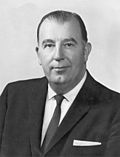Top Qs
Timeline
Chat
Perspective
1960 United States Senate elections
From Wikipedia, the free encyclopedia
Remove ads
The 1960 United States Senate elections coincided with the election of John F. Kennedy as president on November 8, 1960. The 33 seats of Class 2 were contested in regular elections. A special election was also held on June 28, 1960, for a mid-term vacancy in North Dakota where Democrats flipped a seat to expand their majority to 66–34. As Majority Leader Lyndon Johnson was elected Vice President, Mike Mansfield became the new majority leader.
The Republicans gained two seats at the expense of the Democrats. However, Republican Senator-elect Edwin Keith Thomson of Wyoming died December 9, 1960, and was replaced by appointee Democratic John J. Hickey at the beginning of the Congress, reducing Republican gains to one seat. However, this was canceled out by a 1961 special election where Republican John Tower flipped Johnson's Senate seat. The Democrats nonetheless retained a commanding lead in the Senate with 64 seats to 36.
Remove ads
Results summary
Summarize
Perspective
| 64 | 36 |
| Democratic | Republican |
Source: Clerk of the U.S. House of Representatives (1961). "Statistics of the Presidential and Congressional Election of November 8, 1960" (PDF). U.S. Government Printing Office. p. 52.
Remove ads
Gains, losses, and holds
Summarize
Perspective
Retirements
Two Republicans and four Democrats retired instead of seeking re-election.
Defeats
One Democrat sought re-election but lost in the general election.
Post-election changes
Four Republicans died and two Democrats resigned, and were all replaced by appointees. One Republican senator-elect died December 9, 1960 before the next Congress began, and was replaced by a Democratic appointee. In Texas, a 1961 special election was held prior to the 1962 United States Senate elections, where John Tower won the special election to succeed Democratic appointee William A. Blakley, who lost election to finish the term.
Remove ads
Change in composition
After the June special election
| D1 | D2 | D3 | D4 | D5 | D6 | D7 | D8 | D9 | D10 |
| D20 | D19 | D18 | D17 | D16 | D15 | D14 | D13 | D12 | D11 |
| D21 | D22 | D23 | D24 | D25 | D26 | D27 | D28 | D29 | D30 |
| D40 | D39 | D38 | D37 | D36 | D35 | D34 | D33 | D32 | D31 |
| D41 | D42 | D43 | D44 | D45 | D46 | D47 | D48 | D49 | D50 |
| Majority → | D51 | ||||||||
| D60 | D59 | D58 | D57 | D56 | D55 | D54 | D53 | D52 | |
| D61 | D62 | D63 | D64 | D65 | D66 N.D. (sp) Gain |
R34 | R33 | R32 | R31 |
| R21 | R22 | R23 | R24 | R25 | R26 | R27 | R28 | R29 | R30 |
| R20 | R19 | R18 | R17 | R16 | R15 | R14 | R13 | R12 | R11 |
| R1 | R2 | R3 | R4 | R5 | R6 | R7 | R8 | R9 | R10 |
Before the November elections
| D1 | D2 | D3 | D4 | D5 | D6 | D7 | D8 | D9 | D10 |
| D20 | D19 | D18 | D17 | D16 | D15 | D14 | D13 | D12 | D11 |
| D21 | D22 | D23 | D24 | D25 | D26 | D27 | D28 | D29 | D30 |
| D40 | D39 | D38 | D37 | D36 | D35 | D34 | D33 | D32 | D31 |
| D41 | D42 | D43 | D44 Ala. Ran |
D45 Alaska Ran |
D46 Ark. Ran |
D47 Del. Ran |
D48 Ga. Ran |
D49 Ill. Ran |
D50 La. Ran |
| Majority → | D51 Mich. Ran | ||||||||
| D60 R.I. Retired |
D59 Ore. (reg) Ore. (sp) Retired |
D58 Okla. Ran |
D57 N.C. Ran |
D56 N.M. Ran |
D55 Mont. Retired |
D54 Mo. (sp) Ran |
D53 Miss. Ran |
D52 Minn. Ran | |
| D61 S.C. Ran |
D62 Tenn. Ran |
D63 Texas Ran |
D64 Va. Ran |
D65 W.Va. Ran |
D66 Wyo. Retired |
R34 S.D. Ran |
R33 N.J. Ran |
R32 N.H. Ran |
R31 Neb. Ran |
| R21 | R22 | R23 | R24 Colo. Ran |
R25 Idaho Ran |
R26 Iowa Retired |
R27 Kan. Ran |
R28 Ky. Ran |
R29 Maine Ran |
R30 Mass. Ran |
| R20 | R19 | R18 | R17 | R16 | R15 | R14 | R13 | R12 | R11 |
| R1 | R2 | R3 | R4 | R5 | R6 | R7 | R8 | R9 | R10 |
Result of the November elections
| D1 | D2 | D3 | D4 | D5 | D6 | D7 | D8 | D9 | D10 |
| D20 | D19 | D18 | D17 | D16 | D15 | D14 | D13 | D12 | D11 |
| D21 | D22 | D23 | D24 | D25 | D26 | D27 | D28 | D29 | D30 |
| D40 | D39 | D38 | D37 | D36 | D35 | D34 | D33 | D32 | D31 |
| D41 | D42 | D43 | D44 Ala. Re-elected |
D45 Alaska Re-elected |
D46 Ark. Re-elected |
D47 Ga. Re-elected |
D48 Ill. Re-elected |
D49 La. Re-elected |
D50 Mich. Re-elected |
| Majority → | D51 Minn. Re-elected | ||||||||
| D60 S.C. Re-elected |
D59 R.I. Hold |
D58 Ore. (reg) Ore. (sp) Hold |
D57 Okla. Re-elected |
D56 N.C. Re-elected |
D55 N.M. Re-elected |
D54 Mont. Hold |
D53 Mo. (sp) Elected[b] |
D52 Miss. Re-elected | |
| D61 Tenn. Re-elected |
D62 Texas Re-elected[a] |
D63 Va. Re-elected |
D64 W.Va. Re-elected |
R36 Wyo.[c] Gain |
R35 Del. Gain |
R34 S.D. Re-elected |
R33 N.J. Re-elected |
R32 N.H. Re-elected |
R31 Neb. Re-elected |
| R21 | R22 | R23 | R24 Colo. Re-elected |
R25 Idaho Re-elected |
R26 Iowa Hold |
R27 Kan. Re-elected |
R28 Ky. Re-elected |
R29 Maine Re-elected |
R30 Mass. Re-elected |
| R20 | R19 | R18 | R17 | R16 | R15 | R14 | R13 | R12 | R11 |
| R1 | R2 | R3 | R4 | R5 | R6 | R7 | R8 | R9 | R10 |
Beginning of the next Congress
| D1 | D2 | D3 | D4 | D5 | D6 | D7 | D8 | D9 | D10 |
| D20 | D19 | D18 | D17 | D16 | D15 | D14 | D13 | D12 | D11 |
| D21 | D22 | D23 | D24 | D25 | D26 | D27 | D28 | D29 | D30 |
| D40 | D39 | D38 | D37 | D36 | D35 | D34 | D33 | D32 | D31 |
| D41 | D42 | D43 | D44 | D45 | D46 | D47 | D48 | D49 | D50 |
| Majority → | D51 | ||||||||
| D60 | D59 | D58 | D57 | D56 | D55 | D54 | D53 | D52 | |
| D61 | D62 | D63 | D64 Wyo.[c] Gain |
R36 Texas Gain |
R35 | R34 | R33 | R32 | R31 |
| R21 | R22 | R23 | R24 | R25 | R26 | R27 | R28 | R29 | R30 |
| R20 | R19 | R18 | R17 | R16 | R15 | R14 | R13 | R12 | R11 |
| R1 | R2 | R3 | R4 | R5 | R6 | R7 | R8 | R9 | R10 |
Remove ads
Race summaries
Summarize
Perspective
Special elections during the 86th Congress
In these special elections, the winner was seated during 1960 or before January 3, 1961; ordered by election date.
Elections leading to the next Congress
In these general elections, the winners were elected for the term beginning January 3, 1961; ordered by state.
All of the elections involved the Class 2 seats.
Remove ads
Closest races
Summarize
Perspective
Eleven races had a margin of victory under 10%:
Rhode Island was the tipping point state with a margin of 37.8%.
Remove ads
Alabama
Incumbent John J. Sparkman won re-election, having served since 1946. He faced nominal opposition from Republican Julian E. Elgin in the then-deeply Democratic state of Alabama. Sparkman served from 1946 to 1979 in the Senate before retiring and being succeeded by Howell Heflin.
Remove ads
Alaska
Summarize
Perspective
Incumbent Democrat Bob Bartlett was easily re-elected to his second (his first full) term in the U.S. Senate over Republican dentist Lee McKinley after originally being elected in 1958 upon Alaska's anticipated admission as a state into the United States. Bartlett had previously served as the last delegate from Alaska to Congress.
Remove ads
Arkansas
Summarize
Perspective
Incumbent senator John L. McClellan was re-elected to a fourth term with nominal opposition from write-in independent candidate Marvin Fuchs, who received just 449 of 377,485 votes.
Remove ads
Colorado
Summarize
Perspective
Incumbent Gordon Allott was re-elected to a second term in office, defeating lieutenant governor Robert Knous by just under eight percentage points. He would wind up winning re-election in 1966 before retiring in 1973, replaced by Democrat Floyd Haskell.
Delaware
Summarize
Perspective
J. Allen Frear ran for re-election to a third term, but he was defeated by Republican governor J. Caleb Boggs by a narrow 1% margin. Boggs would be re-elected in 1966, but he would lose re-election to a third term in 1972 to future U.S. President Joe Biden.
Remove ads
Georgia
Incumbent Richard B. Russell Jr. was re-elected to a sixth term in office, running unopposed in the tantamount Democratic primary and facing nominal opposition in the deeply-Democratic Georgia.
Remove ads
Idaho
Henry Dworshak ran for re-election to a third term, defeating R.F. McLaughlin by just under five percentage points.
Illinois
Incumbent Paul H. Douglas successfully ran for re-election to a third term, defeating Republican Samuel Witwer.
Iowa
Summarize
Perspective
Incumbent Republican Thomas Martin decided to retire, leaving this seat open. Republican Jack Miller won the open seat, defeating Democrat Herschel C. Loveless and riding the coattails of Richard Nixon's victory in the state.
Kansas
Kentucky
Summarize
Perspective
Incumbent John Sherman Cooper ran for re-election, defeating Keen Johnson by nearly 20%. This was the first time Cooper had won an election to a full Senate term, though he had previously served two partial terms.
Louisiana
Maine
Summarize
Perspective
Incumbent Republican Margaret Chase Smith, the first woman to serve in both houses of Congress, was overwhelmingly re-elected to a third term, defeating Lucia Cormier. This was the first election in which a woman was nominated by both major parties for the office of U.S. Senate, meaning a woman was going to be elected regardless of who won.
Massachusetts
Summarize
Perspective
Republican incumbent Leverett Saltonstall was re-elected to another term after being elected in 1944 in a special election. He defeated Democrat Thomas O'Connor Jr.
Michigan
Summarize
Perspective
Democrat Patrick V. McNamara was narrowly re-elected against Republican Alvin Bentley, having served one full term prior.
Minnesota
Summarize
Perspective
Democrat Hubert Humphrey, who would later become vice president, was re-elected over Republican challenger P. Kenneth Peterson. He had served since 1949.
Mississippi
Incumbent James Eastland, who had represented Mississippi in the Senate since 1943, was elected to another term in a landslide with 92% of the vote.
Missouri (special)
Summarize
Perspective
Following the death of incumbent Thomas C. Hennings, Democrat Edward V. Long, incumbent Lieutenant Governor of Missouri, ran against Republican Lon Hocker for the open seat. Long defeated Hocker by just under seven percentage points.
Montana
Summarize
Perspective
After the retirement of incumbent Democrat James E. Murray, Democrat and representative Lee Metcalf and Republican Orvin Fjare ran for the open seat. Metcalf kept the seat Democratic, winning by just over 1%. This was despite Richard Nixon winning Montana in the concurrent presidential election.
Nebraska
Summarize
Perspective
Republican Carl Curtis, who had served since 1955, was re-elected to a second term over Democrat Robert Conrad by nearly 17 percentage points. Curtis won all but four counties in the state.
New Hampshire
Summarize
Perspective
Bridges died less than a year into his fifth term. With New Hampshire's other Senator Norris Cotton up for re-election in 1962 and following Bridges death. Both of New Hampshire's Senate seats would be up in the 1962 midterms.
New Jersey
Summarize
Perspective
Incumbent Republican Clifford P. Case won re-election against Democrat Thorn Lord. Case would win re-election a few more times in 1966 and 1972, before losing in the 1978 Republican primary.
New Mexico
North Carolina
Summarize
Perspective
Incumbent Democrat B. Everett Jordan was re-elected to his first full term after winning a special election in 1958. He defeated Republican Kyle Hayes by a slightly slimmer margin than he defeated his Republican challenger in 1958.
North Dakota (special)
Summarize
Perspective
A special election was held June 28, 1960, to fill the seat vacated by William Langer, who died November 8, 1959. Clarence Norman Brunsdale, a former Governor of North Dakota, was temporarily appointed to the seat on November 19 of that year until the special election was held. North Dakota Democratic-NPL Party candidate Quentin N. Burdick faced Republican John E. Davis for election to the seat. Davis had been serving as Governor of the state since 1957.[7]
Oklahoma
Summarize
Perspective
Incumbent Democrat Robert Kerr won re-election to a third term, though he would die before the term was up and would be replaced by J. Democrat Howard Edmondson.
Oregon
Summarize
Perspective
First-term Democrat Richard L. Neuberger had been diagnosed with testicular cancer in 1958 that became terminal by 1960 — but was kept from the public. Neuberger remained at home in early 1960, reportedly battling the flu. Though still publicly seeking re-election, he told his campaign chair, attorney Jack Beatty, "Remember, there's always another Neuberger," referring to his wife. The comment, combined with Neuberger's reluctance to meet in public and weak voice on the phone, led Beatty to believe that Neuberger's condition was grave, a suspicion confirmed by the Senator's physician shortly before Neuberger died at Good Samaritan Hospital on March 9, 1960.[8][9]
Democratic Oregon Supreme Court judge Hall S. Lusk was appointed March 16, 1960, to continue the term, pending a special election in which he was not a candidate.
Primaries were held May 20, 1960, in which Neuberger's widow, Democrat Maurine B. Neuberger and the Republican former-Governor of Oregon Elmo Smith easily won nomination.[10][11]
Maurine Brown Neuberger was elected November 8, 1960, both to finish the term and to the next term.
Oregon (special)
This section needs expansion. You can help by adding to it. (May 2020) |
Oregon (regular)
This section needs expansion. You can help by adding to it. (July 2020) |
Maurine Brown Neuberger retired at the end of the term.
Rhode Island
South Carolina

South Dakota
Tennessee
Texas
Summarize
Perspective
Incumbent two-term Democrat Lyndon Johnson was easily re-elected, but he was also elected the same day as Vice President with John F. Kennedy being elected president. This was the last election in which a Democrat was selected to Texas's class 2 Senate seat.
Johnson resigned January 3, 1961 — before the new Congress began — and former Democratic senator William A. Blakley was appointed to begin the term, pending a special election. Republican John Tower, who lost to Johnson here in 1960, would win that May 1961 special election.
Virginia
Summarize
Perspective
Incumbent Democrat Absalom Willis Robertson was overwhelmingly re-elected with 81% of the vote, facing no Republican opposition.
West Virginia
Summarize
Perspective
Incumbent Jennings Randolph won re-election against Cecil Underwood, the incumbent governor of West Virginia.
Wyoming
Senator-Elect Thomson died a month after his election.
See also
Notes
- Johnson was elected in the Senate election, but did not take office to the next term after John F. Kennedy won the presidential election when Johnson was assuming the vice presidency. Mike Mansfield became the new majority leader at the beginning of the 87th United States Congress on January 3, 1961.
- Edwin Keith Thomson, the Republican senator-elect as a result of the November election, died on December 9; Democrat John J. Hickey was appointed in his place and seated at the beginning of the Congress.[2]
- The Minnesota Democratic–Farmer–Labor Party is affiliated nationally with the Democratic Party (United States).
References
Bibliography
Wikiwand - on
Seamless Wikipedia browsing. On steroids.
Remove ads






























































































